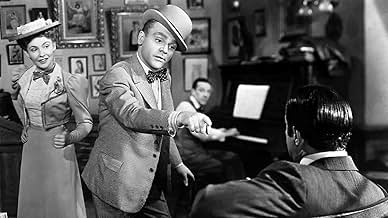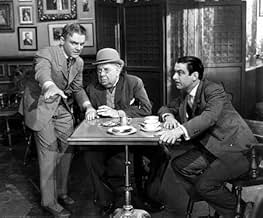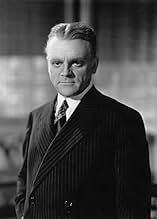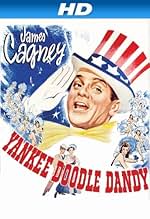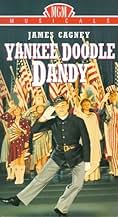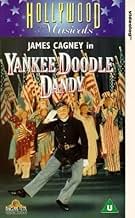IMDb RATING
7.6/10
18K
YOUR RATING
The life of the renowned musical composer, playwright, actor, dancer, and singer George M. Cohan.The life of the renowned musical composer, playwright, actor, dancer, and singer George M. Cohan.The life of the renowned musical composer, playwright, actor, dancer, and singer George M. Cohan.
- Won 3 Oscars
- 9 wins & 6 nominations total
Patsy Parsons
- Josie Cohan - As a Girl of 12
- (as Patsy Lee Parsons)
Featured reviews
So it takes liberties with facts. So it's jingoistic. Big deal! I adore it for its depiction of turn-of-the-(20th}century New York, especially its theater, which has fascinated me for years. And it has the breath-taking performance of Jimmy Cagney in the title role; he's absolutely elecrifying in the musical numbers. If some scenes are mawkish, well, I think that can be forgiven.
This movie, above all others, make me so proud to be an American.
This movie, above all others, make me so proud to be an American.
Right from the start, I have to say you do not need to be an American to be caught up in the excitement of the blatant flag waving tribute to a great artist. "Yankee Doodle Dandy" made to boost morale after the U.S. entered the war surely would have achieved its goal. It would have been even better in Technicolor (not the coloured version later shown). The songs were great, the acting and the individual dancing style of James Cagney was superb and deserved the Oscar. The two scenes featuring "Over There" were very moving with Frances Langford a standout! The story, while bearing small resemblance to real life, was good and Walter Huston and Rosemary de Camp were excellent. When you see a film such as this some 60 years after its release, and still really enjoy it, it shows how the Golden Years of Hollywood were just that.
The amazing piece of timing here is when Warner Bros. began work on this biography of entertainer George M. Cohan, WWII had not yet broken out. The attack on Pearl Harbor occurred the day before shooting began. When the film opened people on the home front badly needed some morale boosting, and this film gave it to them. It's just a joyous musical costume piece from start to finish with nice comic touches balanced with some sentimental moments (supposedly Walter Huston's deathbed scene had even taskmaster director Michael Curtiz crying). There's nothing in the way of real conflict or even much heavy in the way of romance between Cohan and his fictitious film wife "Mary", who was modeled after Cohan's actual second wife in some ways. Cohan was actually married twice. Oddly enough, it was Cohan who said he wanted as little romance in the film as possible.
The more I learn about Cohan the more I realize that Cagney was perfect to play him - both Irish Americans, both about the same size and build, and George Cohan's style of dancing and singing were about the same as Cagney's. It's hard to believe that Fred Astaire was Cohan's first choice to play himself. Astaire was a great talent, but I don't think he could have conveyed the combination of mischief, optimism and energy that was Cohan the way that Cagney ultimately did. Several people criticize Cagney's dancing here, but that eccentric style was Cohan's, who always considered himself more of an overall entertainer than a dancer in the first place.
If you're "date conscious" as I am, there are some matters of plot that might bother you. Cohan was born on July 2 or 3, not July 4. Cohan's mother outlived his father by eleven years and Cohan's father was not "very old" when he died as is said in the film - at least by today's standards. When Cohan's father died in 1917, he was only 69. Cohan's sister did die young - she was only 39, dying in 1916, plus she was not his little sister. Instead Josie was a year older than George. The film has Josie marrying when she would have been close to forty, when she actually married at the beginning of the 20th century and thus was the one to break up the four Cohans, not George. Also, Cohan received his Congressional Medal in 1936, not as WWII began as shown in the film. However the plot device of having George M. recount his life story to FDR, receiving his Congressional medal in the Oval Office, and then dance joyously down the White House stairs and into the streets joining a group of marching soldiers in a chorus of "Over There" was probably a great way to bridge Cohan's patriotic past with what was then an uncertain time that certainly needed a dose of his optimism.
The one thing that I did find a little odd - and one thing isn't much in a two plus hour long movie - is that it is hard to spot the actual point in the film where Mary becomes George's wife. There is quite a bit of domesticity shown before the two were married. Mary is cooking for George, staying in his apartment alone waiting for him to come home from the show, and acting very much like they are already married. The only way you know they are not is that George very subtly pops the question to the point that I'm surprised even Mary knew what he was asking! I know this doesn't seem like much in today's world, but considering that they were trying to paint Cohan in the most positive light possible and that the living arrangements might be misunderstood, I am surprised that the censors of that time never raised the issue.
At any rate, I highly recommend this one. You'll have a great time, at least in part because you can see that Cagney is having a great time. He always said this film was his favorite, and it shows in his performance.
The more I learn about Cohan the more I realize that Cagney was perfect to play him - both Irish Americans, both about the same size and build, and George Cohan's style of dancing and singing were about the same as Cagney's. It's hard to believe that Fred Astaire was Cohan's first choice to play himself. Astaire was a great talent, but I don't think he could have conveyed the combination of mischief, optimism and energy that was Cohan the way that Cagney ultimately did. Several people criticize Cagney's dancing here, but that eccentric style was Cohan's, who always considered himself more of an overall entertainer than a dancer in the first place.
If you're "date conscious" as I am, there are some matters of plot that might bother you. Cohan was born on July 2 or 3, not July 4. Cohan's mother outlived his father by eleven years and Cohan's father was not "very old" when he died as is said in the film - at least by today's standards. When Cohan's father died in 1917, he was only 69. Cohan's sister did die young - she was only 39, dying in 1916, plus she was not his little sister. Instead Josie was a year older than George. The film has Josie marrying when she would have been close to forty, when she actually married at the beginning of the 20th century and thus was the one to break up the four Cohans, not George. Also, Cohan received his Congressional Medal in 1936, not as WWII began as shown in the film. However the plot device of having George M. recount his life story to FDR, receiving his Congressional medal in the Oval Office, and then dance joyously down the White House stairs and into the streets joining a group of marching soldiers in a chorus of "Over There" was probably a great way to bridge Cohan's patriotic past with what was then an uncertain time that certainly needed a dose of his optimism.
The one thing that I did find a little odd - and one thing isn't much in a two plus hour long movie - is that it is hard to spot the actual point in the film where Mary becomes George's wife. There is quite a bit of domesticity shown before the two were married. Mary is cooking for George, staying in his apartment alone waiting for him to come home from the show, and acting very much like they are already married. The only way you know they are not is that George very subtly pops the question to the point that I'm surprised even Mary knew what he was asking! I know this doesn't seem like much in today's world, but considering that they were trying to paint Cohan in the most positive light possible and that the living arrangements might be misunderstood, I am surprised that the censors of that time never raised the issue.
At any rate, I highly recommend this one. You'll have a great time, at least in part because you can see that Cagney is having a great time. He always said this film was his favorite, and it shows in his performance.
There are many, many James Cagney films that show his enormous talent as an actor. He was equally at home in musicals, dramas and comedies. While I have always been a fan and appreciate his unusual scope, this movie in particular caught my eye and totally blew me away when the scene I'm about to describe unfolded.
Near the very end of the film Cagney's character (George M. Cohan) bids farewell to the President and leaves the room. There is a long, open staircase he starts walking down. As he walks you sense a bit of a bounce beginning to take over his step.....one that quickly gives way to an awesome dance as he navigates the stairway. Many will not note, but this dance was a fantastic achievement on two fronts. One, it was done in one "take"...that is, the camera never stopped; the scene never "cut." The camera stays with him in one shot all the way through. Second, Mr. Cagney never ONCE looks at his feet or down at the steps. It's almost impossible to WALK down a staircase without looking down or hanging on to a banister....this man DANCED down a staircase without benefit of seeing or touching anything.
Couple this feat with the brilliant display of "hoofing" he gives earlier in the film when he literally dances up the walls and you have a movie that deserves its "classic" rating. If you haven't seen it please make it a point to do so. Any movie that is awe inspiring 62 years later must be worth a peek, don't you agree?
Near the very end of the film Cagney's character (George M. Cohan) bids farewell to the President and leaves the room. There is a long, open staircase he starts walking down. As he walks you sense a bit of a bounce beginning to take over his step.....one that quickly gives way to an awesome dance as he navigates the stairway. Many will not note, but this dance was a fantastic achievement on two fronts. One, it was done in one "take"...that is, the camera never stopped; the scene never "cut." The camera stays with him in one shot all the way through. Second, Mr. Cagney never ONCE looks at his feet or down at the steps. It's almost impossible to WALK down a staircase without looking down or hanging on to a banister....this man DANCED down a staircase without benefit of seeing or touching anything.
Couple this feat with the brilliant display of "hoofing" he gives earlier in the film when he literally dances up the walls and you have a movie that deserves its "classic" rating. If you haven't seen it please make it a point to do so. Any movie that is awe inspiring 62 years later must be worth a peek, don't you agree?
`It seems it always happens
Whenever we get too high hat and sophisticated for flag-waving, some thug nation decides we're a pushover, all ready to be blackjacked. It's not long before we start looking up mighty anxiously to make sure the flag is still waving.'
So says James Cagney, as George M. Cohan, at the time of the sinking of the Lusitania in 1915. Obviously, it's a sentiment that has great relevance to our time, as well. I've always wished I could dance a patriotic dance or march down the street waving the flag. It looks like a lot of fun. The trouble is, this sort of activity is often performed to suppress what America is really about. The really great thing about our country isn't songs, flags and marches. Any country can do those things. The real great thing is that we have the right to say what we think, to debate the issues of the day and to form a consensus for action when we are in agreement about what needs to be done.
There was surely such a consensus when this film was made in 1942. There was little doubt about what needed to be done then. However, World War I seems now a particularly pointless conflict and the thought that smiling Frances Langford was singing soldiers into battle to who knows what fate is a little disturbing. And now, whenever there is a war, we are urged to join the parade and postpone debate until the issue is something not so important, like farm prices or college entrance requirements. It seems to me that the more important an issue is, the more we should be debating it. If people are going to die, we'd better make sure we are right.
From that point of view, `Yankee Doodle Dandy' can seem almost offensive. But, of course it isn't. Is a charming example of one of the thing Old Hollywood did best- the romantic biography. In this George M. is an all-right guy, an enormous bundle of energy that intimidates the stuffed shirts but causes people of substance to fall in love with him. He has a wonderful family and one of those `perfect' Hollywood wives- Mary, who doesn't even wince when he gives the song he wrote for her to another actress. He has a loyal friend and partner in Jed Harris. For some reason he's childless but still gets a thrill from performing for his beloved audiences. And, when his country needs a shot in the arm, his enthusiastic songs provide it.
Of course, he was married twice. His divorce from his first wife Ethel, was acrimonious and thus she doesn't appear in the story. `May' is a fictionalized version of his second wife Agnes. He had children but they also didn't make the cut because he was estranged from them at the time of the film. He was loathed by many of his profession for years before this because of his strong anti-union stance. His split with Jed Harris was not the gentle retirement we see here but was, at least in part because Harris had given in to the unions. And he himself loathed Franklin Roosevelt, refusing for four years to pick up the medal FDR and Congress had awarded him. Would it have been a better movie if these things were incorporated into the script? Probably not. Hollywood- and the nation at the time- was more concerned with the way things should have been than with the way they actually were.
Cagney was surely a perfect choice to play Cohan, being an Irishman who enter show business as a song and dance man, (and always considered himself primarily that). His exuberant personality also mirrors that of Cohan, who was said not to be particularly great at anything but did everything with such enthusiasm that it didn't matter. That said, I have never been a particular fan of Cagney's `puppet on a string' dance style. Dancing is supposed to be an expression of one's inner self. A puppet has no inner self.
There are many charming sequences in the film, none more so than the `cute-meet' with Mary where he's played a dottering old man in a play and she thinks he really is one until he starts showing her dance steps. Then there's his refusal by the Army because of his age. He does another dance routine to show them what they are missing. You've got to love the sequence where he and Harris, (Richard Whorf), con Cuddles Zakal into backing them. Then there's a glimpse of Cagney cute sister, Jeanne, playing Josie, Cohan's sister. We are not told why Josie is `gone' late in the film- her heart attack at age 36 was deemed too unpleasant, as was the death of Cohan's mother, (Rosemary Decamp, who was more than a decade younger than Cagney). The one death scene is that of Cohan's beloved father, played by Walter Huston, who was a Cohan protégé. Chan himself was on his deathbed as this was released, (he submitted a script which was `tactfully rejected'). He escaped his nurse to see it in a theater and gave it his approval, as we should, too.
So says James Cagney, as George M. Cohan, at the time of the sinking of the Lusitania in 1915. Obviously, it's a sentiment that has great relevance to our time, as well. I've always wished I could dance a patriotic dance or march down the street waving the flag. It looks like a lot of fun. The trouble is, this sort of activity is often performed to suppress what America is really about. The really great thing about our country isn't songs, flags and marches. Any country can do those things. The real great thing is that we have the right to say what we think, to debate the issues of the day and to form a consensus for action when we are in agreement about what needs to be done.
There was surely such a consensus when this film was made in 1942. There was little doubt about what needed to be done then. However, World War I seems now a particularly pointless conflict and the thought that smiling Frances Langford was singing soldiers into battle to who knows what fate is a little disturbing. And now, whenever there is a war, we are urged to join the parade and postpone debate until the issue is something not so important, like farm prices or college entrance requirements. It seems to me that the more important an issue is, the more we should be debating it. If people are going to die, we'd better make sure we are right.
From that point of view, `Yankee Doodle Dandy' can seem almost offensive. But, of course it isn't. Is a charming example of one of the thing Old Hollywood did best- the romantic biography. In this George M. is an all-right guy, an enormous bundle of energy that intimidates the stuffed shirts but causes people of substance to fall in love with him. He has a wonderful family and one of those `perfect' Hollywood wives- Mary, who doesn't even wince when he gives the song he wrote for her to another actress. He has a loyal friend and partner in Jed Harris. For some reason he's childless but still gets a thrill from performing for his beloved audiences. And, when his country needs a shot in the arm, his enthusiastic songs provide it.
Of course, he was married twice. His divorce from his first wife Ethel, was acrimonious and thus she doesn't appear in the story. `May' is a fictionalized version of his second wife Agnes. He had children but they also didn't make the cut because he was estranged from them at the time of the film. He was loathed by many of his profession for years before this because of his strong anti-union stance. His split with Jed Harris was not the gentle retirement we see here but was, at least in part because Harris had given in to the unions. And he himself loathed Franklin Roosevelt, refusing for four years to pick up the medal FDR and Congress had awarded him. Would it have been a better movie if these things were incorporated into the script? Probably not. Hollywood- and the nation at the time- was more concerned with the way things should have been than with the way they actually were.
Cagney was surely a perfect choice to play Cohan, being an Irishman who enter show business as a song and dance man, (and always considered himself primarily that). His exuberant personality also mirrors that of Cohan, who was said not to be particularly great at anything but did everything with such enthusiasm that it didn't matter. That said, I have never been a particular fan of Cagney's `puppet on a string' dance style. Dancing is supposed to be an expression of one's inner self. A puppet has no inner self.
There are many charming sequences in the film, none more so than the `cute-meet' with Mary where he's played a dottering old man in a play and she thinks he really is one until he starts showing her dance steps. Then there's his refusal by the Army because of his age. He does another dance routine to show them what they are missing. You've got to love the sequence where he and Harris, (Richard Whorf), con Cuddles Zakal into backing them. Then there's a glimpse of Cagney cute sister, Jeanne, playing Josie, Cohan's sister. We are not told why Josie is `gone' late in the film- her heart attack at age 36 was deemed too unpleasant, as was the death of Cohan's mother, (Rosemary Decamp, who was more than a decade younger than Cagney). The one death scene is that of Cohan's beloved father, played by Walter Huston, who was a Cohan protégé. Chan himself was on his deathbed as this was released, (he submitted a script which was `tactfully rejected'). He escaped his nurse to see it in a theater and gave it his approval, as we should, too.
Did you know
- TriviaMany facts were changed or ignored to add to the feel of the movie. For example, the real George M. Cohan was married twice, and although his second wife's middle name was Mary, she went by her first name, Agnes. In fact, the movie deviated from the truth to such a degree that Cohan's daughter Georgette commented, "That's the kind of life Daddy would have liked to have lived."
- GoofsThe "You're A Grand Old Flag" number, supposedly takes place in the 1906 production of "George Washington Jr.," and uses multiple period flags to represent times before 1906. The Civil War flag, as an example, is correct for the time in question. However, in the final sequence characters carry, and an soft screen projection is made of, multiple 48 star flags. The 48 star flag was not introduced until 1912. In 1906, it should have been a 45 star flag. (Oklahoma was admitted to the Union in 1907, New Mexico and Arizona in 1912).
- Quotes
George M. Cohan: My mother thanks you, my father thanks you, my sister thanks you, and I thank you.
- Alternate versionsAlso available in a computer colorized version.
- ConnectionsFeatured in The Voice That Thrilled the World (1943)
- SoundtracksThe Yankee Doodle Boy
(1904) (uncredited)
from the Broadway Show "Little Johnny Jones"
Written by George M. Cohan
Played during the opening credits
Sung and Danced by James Cagney and Chorus
- How long is Yankee Doodle Dandy?Powered by Alexa
Details
- Release date
- Country of origin
- Language
- Also known as
- El canto de la victoria
- Filming locations
- Production company
- See more company credits at IMDbPro
Box office
- Gross US & Canada
- $11,800,000
- Runtime
- 2h 6m(126 min)
- Color
- Aspect ratio
- 1.37 : 1
Contribute to this page
Suggest an edit or add missing content



